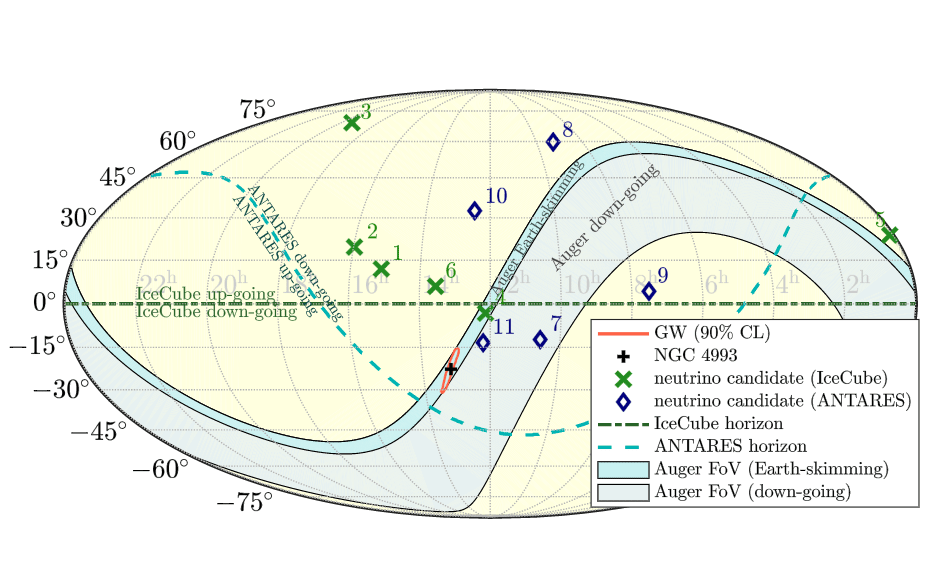Today, the LIGO and Virgo collaborations have announced the detection of a new gravitational wave event, GW170817, which constitutes the first time that a binary neutron star merger has been detected with the LIGO observatory. This unique observation is even more compelling since the same collision was seen by the Fermi and INTEGRAL satellites as a result of a short gamma-ray burst (GRB) and, subsequently, across the electromagnetic spectrum, with radio, optical, and X-ray detections. These observations made it possible for the first time to pinpoint the source location of a gravitational wave event. The source was found to be in a galaxy 130 million light years away, known as NGC 4993.
In a joint effort by the ANTARES, IceCube, Pierre Auger, LIGO, and Virgo collaborations, scientists have searched for neutrino emission from this merger. The search looked for neutrinos in the GeV to EeV energy range and did not find any neutrino in directional coincidence with the host galaxy. The nondetection agrees well with our expectation from short GRB models of observations at a large off-axis angle, which is most likely the case for the GRB detected in conjunction with GW170817. These results have just been submitted to The Astrophysical Journal.

The detection of a gravitational wave event is always exciting news for astrophysicists, but having one also confirmed for the first time by other instruments that detect photons is even more exciting. It marks the beginning of a new era of multimessenger astrophysics. For IceCube scientists, it is another step toward the time when cosmic events will be detected and studied with neutrinos, light, and gravitational waves together.
The combined gravitational wave and gamma-ray observation of this event tells us that there was particle acceleration by the source, which provides insight into the merger process and also means that very high energy neutrinos might have been produced. The detection of neutrinos would reveal even more information about the merger, including the density and energy of the hadrons involved and the energy dissipation mechanisms.
The search for neutrino emission from this collision of two neutron stars has been conducted in collaboration with both the ANTARES and Pierre Auger observatories, which bring improved sensitivities at different energies. At the exact time of the merger, the source could fortuitously be seen from an ideal viewing angle by the Pierre Auger observatory. For IceCube and ANTARES, the direction to the source was in a part of the sky where the detectors are less sensitive, but still capable of making significant observations.
The first study concentrated on a time window within 500 seconds around the detection of GW170817, and yielded no associated neutrino events. Later, scientists expanded the search to include possible emission of high-energy neutrinos up to 14 days after the merger, suggested by theoretical predictions, and also searched for lower energy neutrinos associated with the merger remnant and ejected material. These follow-up studies did not find any significant emission either.
The lack of neutrino emission from GW170817 is in good agreement with the observation of a GRB from a high viewing angle, i.e., with the outflow jet not pointing toward Earth.
IceCube has already proven the existence of an extragalactic flux of astrophysical neutrinos and has searched jointly with ANTARES for neutrino emission from other gravitational wave sources, e.g., binary black holes GW150914 or GW151226. With a growing network of gravitational-wave detectors, it is expected that many more binary neutron star mergers will be discovered in the near future, expanding the capability to study these sources through high-energy neutrinos with IceCube and through findings from joint studies with other neutrino telescopes.
info “Search for high-energy neutrinos from binary neutron star merger GW170817 with ANTARES, IceCube, and the Pierre Auger Observatory,” The ANTARES Collaboration, the IceCube Collaboration, the Pierre Auger Collaboration, the LIGO Scientific Collaboration and the Virgo Collaboration, The Astrophysical Journal 850 (2017) L35, iopscience.iop.org arxiv.org
info “GW170817: Observation of Gravitational Waves from a Binary Neutron Star Inspiral,” B. P. Abbott et al. (LIGO Scientific Collaboration and Virgo Collaboration), Phys. Rev. Lett. 119, 161101, DOI:10.1103/PhysRevLett.119.161101
info “Multi-messenger Observations of a Binary Neutron Star Merger,” B. P. Abbott et al., The Astrophysical Journal Letters 848:L12(59pp), arXiv.org DOI:10.3847/2041-8213/aa91c9